By Folke Myrvang
During the Second World War a lot of research and development was entered into silenced weapons in the British service. The Welrod pistol, the DeLisle carbine and the silenced Sten guns are the most widely known and successful results of these developments. The silenced Sten was made in a number of variations and the exact details have never been revealed. The author went through all the surviving documents on this subject he could find in the British archives and examined dozens of silenced Sten guns in order to write the following article that shows four basic models with variations and prototypes.
he developments were initiated by the I.S.R.B. (Inter Service Research Bureau), which was a cover name for the SOE (Special Operations Executive). Silenced weapons were in demand for the agents that were working behind enemy lines in the countries occupied by the Germans. Short of silenced weapons, the options were chloroform, clubs or knives. The desire was to find a weapon precise and powerful enough that it could kill a man within 50 yards; night sights were required and the weapon should be repeating or self loading.
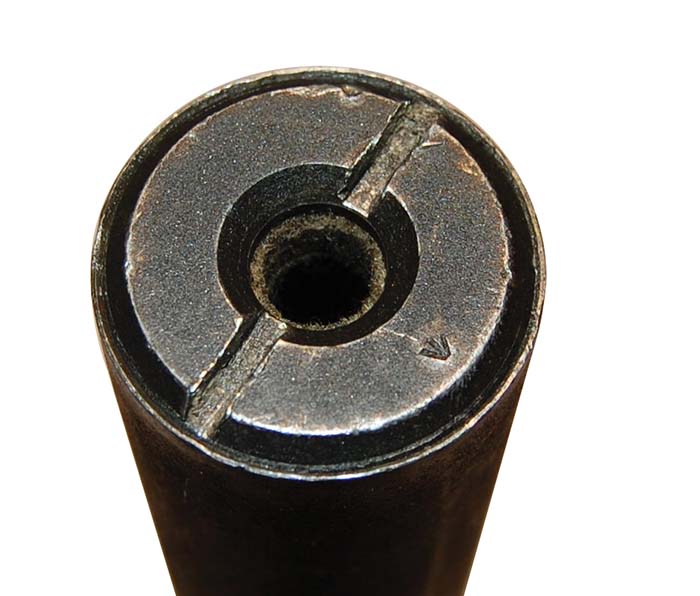
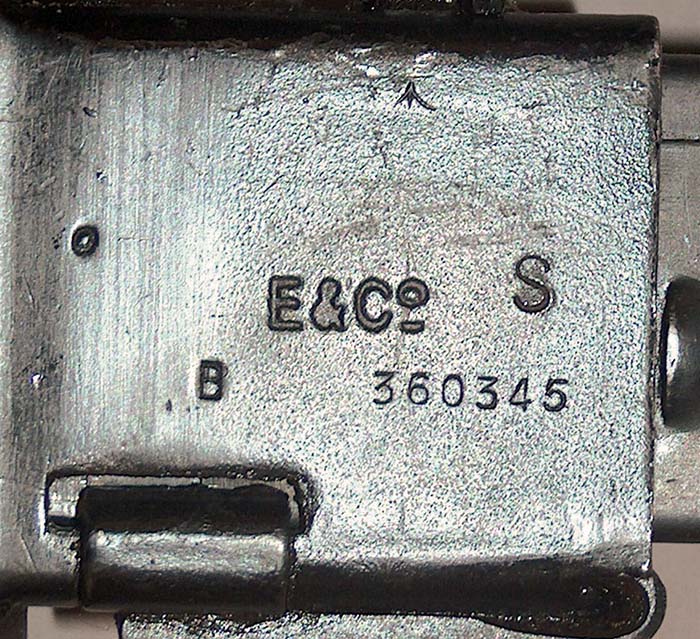
In the fall of 1941, an adaptation of the Winchester Model 94 rifle in .30-30 Winchester caliber was considered. 2-300 rifles were available in England already and could be easily equipped with Cochrane Barnett night sights and Parker Hale would be called upon to produce Maxim silencers for the lever action rifles. Handloaded ammunition would be necessary to achieve subsonic velocities. Shortly thereafter it was suggested to equip a number of Martini Henry carbines in .577/450 caliber with silencers and smokeless powdered ammunition. A small number of Luger pistols were equipped with Parker Hale-type silencers, and while some examples are extant, it is not known today whether they were issued or not.
Silenced submachine guns became a demand from both the SOE and the regular army. With the introduction of the Mark II Sten with its easily detachable barrel and shroud, it was inevitable that a silencing unit would be developed for it. The first tests were held during the summer of 1942 when a number of silenced Sten guns and Thompsons were tested. The tests were rather optimistic and involved the reduction of sound and flash signatures, precision at 200 meters and penetration at 300 meters. The Sten silencers were made by Enfield, while the Thompson units were made by J. Armstrong & Co.
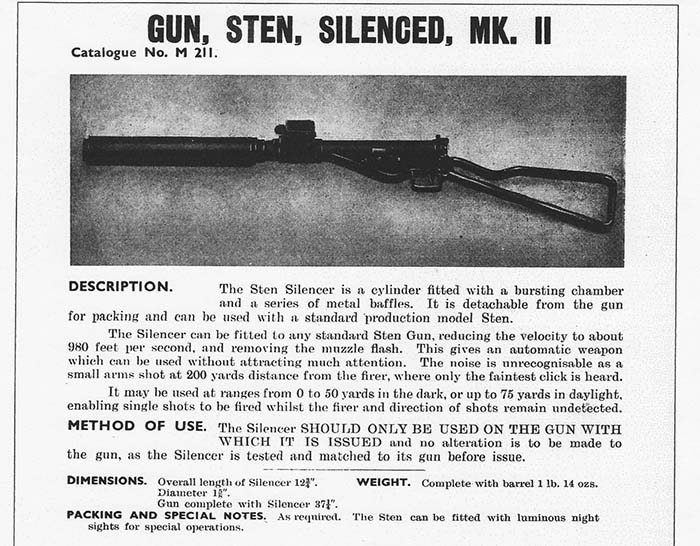
The silenced submachine guns were designated Special Sten and Special Thompson and the Sten was most favorably received. Both of the Thompson silencers used in the test burst during firing while the Sten silencers were still operable after the test was finished. The nomenclature “Special Sten” was decided on for official use.
Unfortunately, we have no photographs showing the various prototypes of the Sten silencers except for a couple of surviving examples in the former MOD Pattern Room collection, which is now part of the National Firearms Centre in Leeds, UK. The surviving prototypes have silencers that are 22 inches long and would make the weapons clumsy for handling in combat. They feature a lightened bolt that was necessary in order to make them function as their ventilated barrels would reduce the power of the ammunition. It is likely that this silencing unit is the one reported to have been designed by the Polish lieutenant Kulikowski for the SOE. A surviving Thompson with silencer also resides in the same collection.
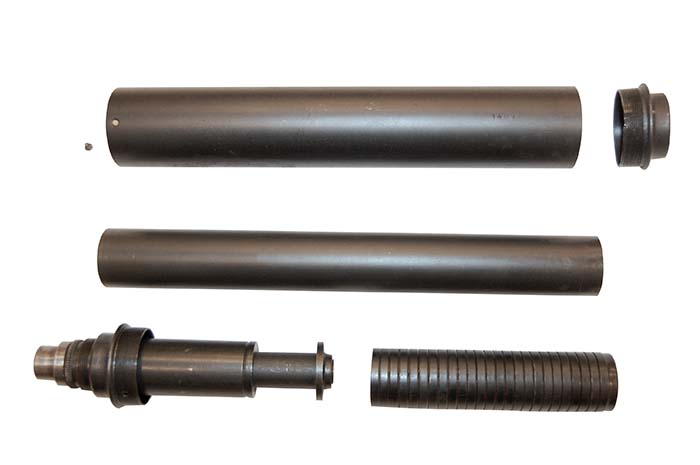
It is apparent that the SOE distributed small series of silenced Sten guns to the agents and resistance forces while the testing was still going on in England and no model had been approved for official use. In September 1942, a batch of 110 silenced Stens were delivered to the SOE. The distinctive rattling sound of the bolt of the silenced Sten was a concern for the British and several steps were taken to try to muffle this sound without any success. The bronze bolt has been rumored to have been introduced for the purpose of eliminating the steel “clank” of the bolt in the silenced Sten. It must be noted that the bronze bolts had nothing to do with the silencers. Bronze was simply an available material that could be used to make bolts in quantity with reduced machining costs.
More than one organization was involved in designing silenced versions of the Sten. The regular army had its eyes on this project as well and The Small Arms Group of the Ministry of Supply Armaments Design Corporation was responsible for designing what became the Sten MkII(S). The SOE were in more of a hurry than the army and a number of silencers were tested during the development.
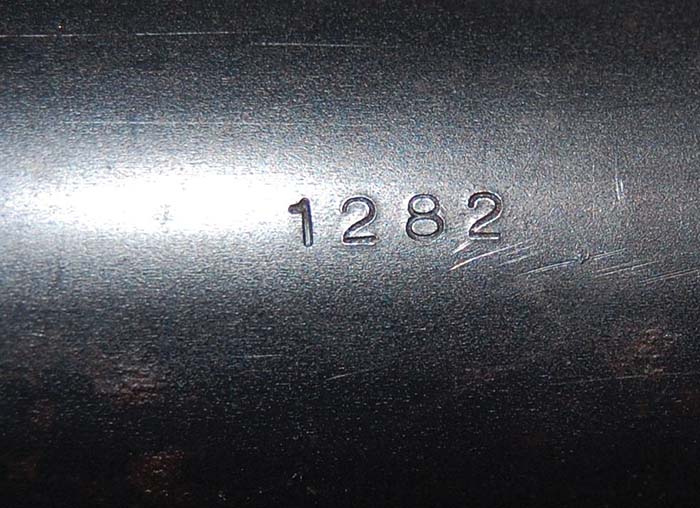
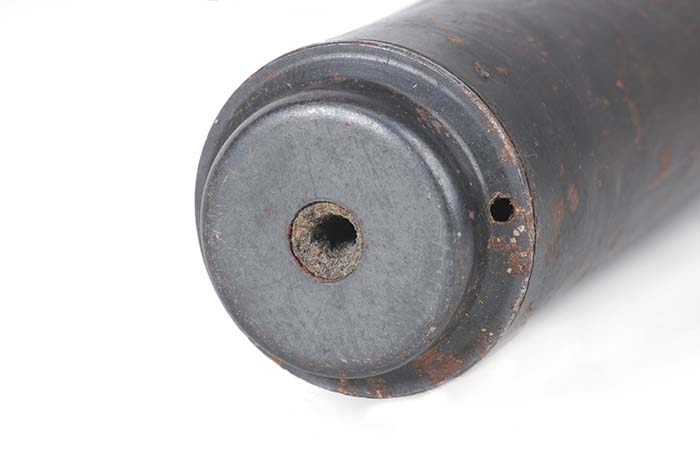
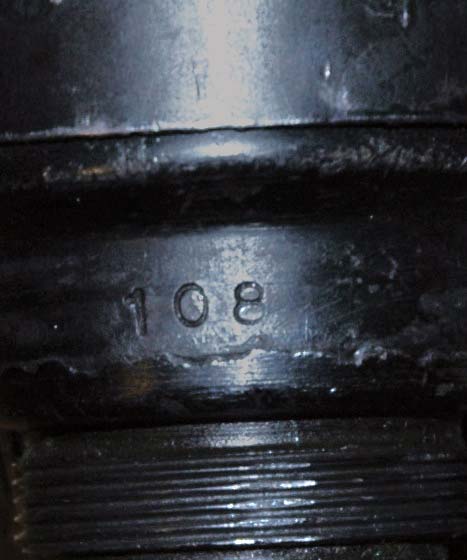
Further tests were carried out in October and November of 1942 with silencers designed by the C.S.A.D. (Chief Superintendent of Armament Design), who appears to have been the one developing the silencing units for the army, and C.I.S.A. (Chief Inspector Small Arms) design department who appears to have developed the SOE silencing units. A host of various silencers were tested, but again there are no surviving illustrations explaining the differences or showing the various models that we have been able to find so far. At this point it was decided to abandon all tests with silencers for Thompsons and go further with only the Sten gun silencers. It was also decided to try to make one Sten gun silencer that would combine the best features of the prototypes and would be easy to manufacture. This turned out to not be the final result.
In Norway a number of silenced Sten Mk.II have been observed with what appears to be a shorter version of the 22-inch long prototype mentioned above. As several reports refer to shortened Kulikowski silencing units, it is possible that this silencing unit, described below as the first production model, is indeed a “shortened Kulikowski.” Most of the silencing units in Norway appear to have their origin from the resistance forces and the SOE.
In January 1943 yet another batch of silencers were completed. Hand guards made of webbing material to protect the operators hands from getting burned were also ordered to place around the asbestos string wrapped around the silencers. During the same time tests were carried out with the short and compact Welgun and Sten Mk.IV submachine guns, some of which were also silenced. It was quickly decided that it would be desirable to stay away from adopting new designs into the service if it could be avoided and only a few specimens were produced of these models.
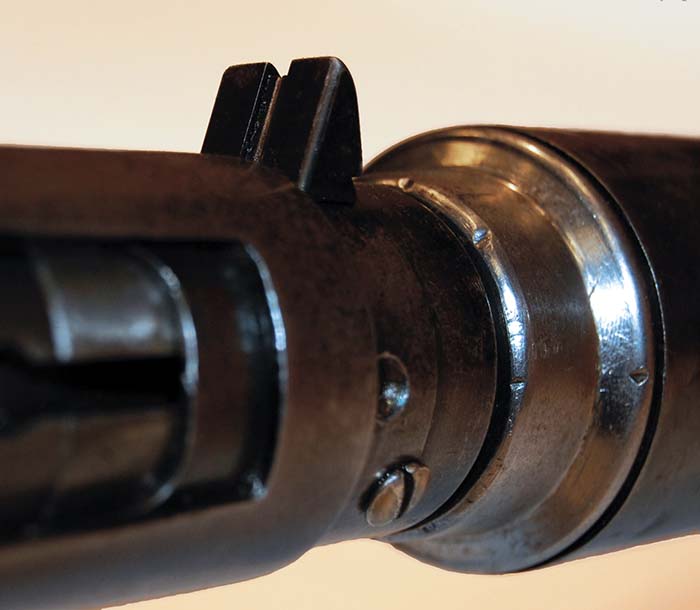
Throughout 1943 the testing continued and small batches of silenced “Special” Stens were also shipped off and used in various operations in Europe. It appears that a model from C.E.A.D. (Chief Engineer Armament Design) was chosen as the official Sten silencer for the British army. Experiments with lighter bolts and shortened recoil springs had been undertaken.
On January 31, 1944, the designation Sten 9mm Machine Carbine Mk.II(S) was used for the first time. At the same time it was decided to stop using the nomenclature Special Sten and refer to the weapons as Mk.II(S) instead.
In July 1944, a letter was sent from the Director of Infantry to the Director of Artillery, Small Arms regarding the use of two similar silencing units for Sten guns and the fact that “Attachment no.6, Sten Machine Carbine, Mark 1, design E.S.6(W.D.)” was not approved for use by the British army, but still found in army stores. The E.S.6(W.D.), (Experimental Station 6, (War Department)) silencing unit was made for use by the SOE agents and E.S.6(W.D.) was a cover name for SOE Station XII.
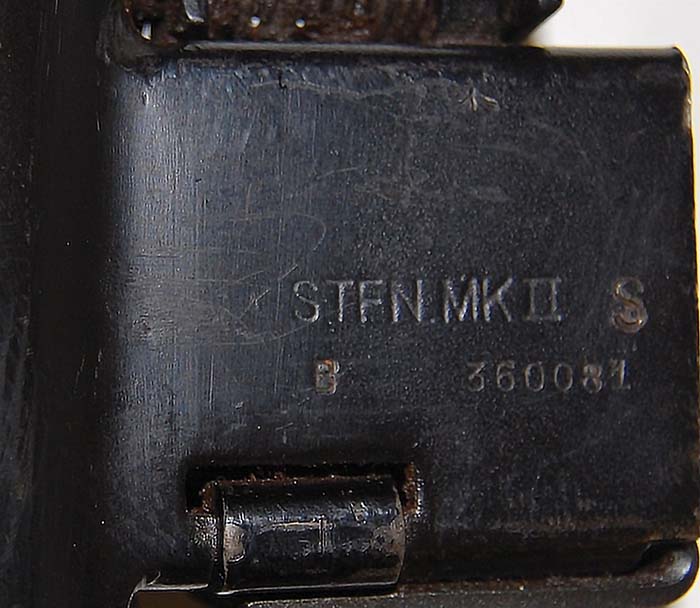
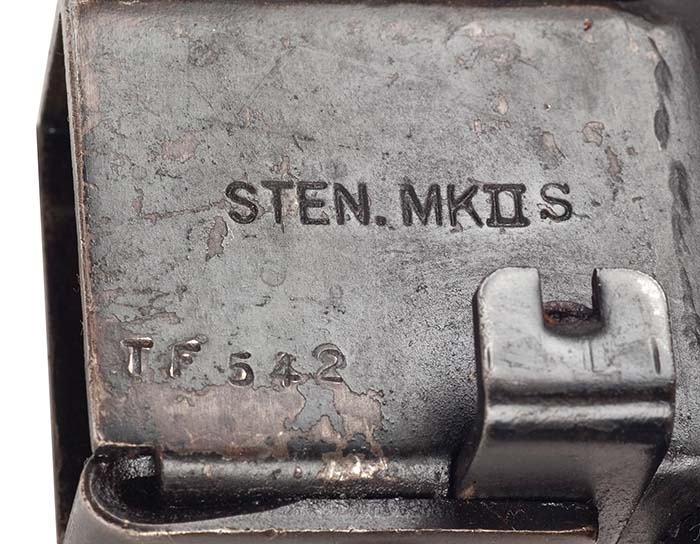
No reason has been found for the SOE procurement of different silencing units than the one adopted by the army. SOE participated in the developments and it seems strange that they would make their own models, but all three models exist in numbers. The only reason was, as mentioned above, that the SOE were in such a hurry that they were not prepared to wait for the final decision by the army. The use of the army silencing unit was discontinued in March 1945 and all further manufacture would be of the E.S.6(W.D.) model.
One of the challenges found with silencing the Sten guns was the recurring double taps or even runaway guns because the silencing units reduced the power of the ammunition so much that the bolt did not go far enough to the rear to get caught by the sear. This was also a problem with the regular Sten guns.
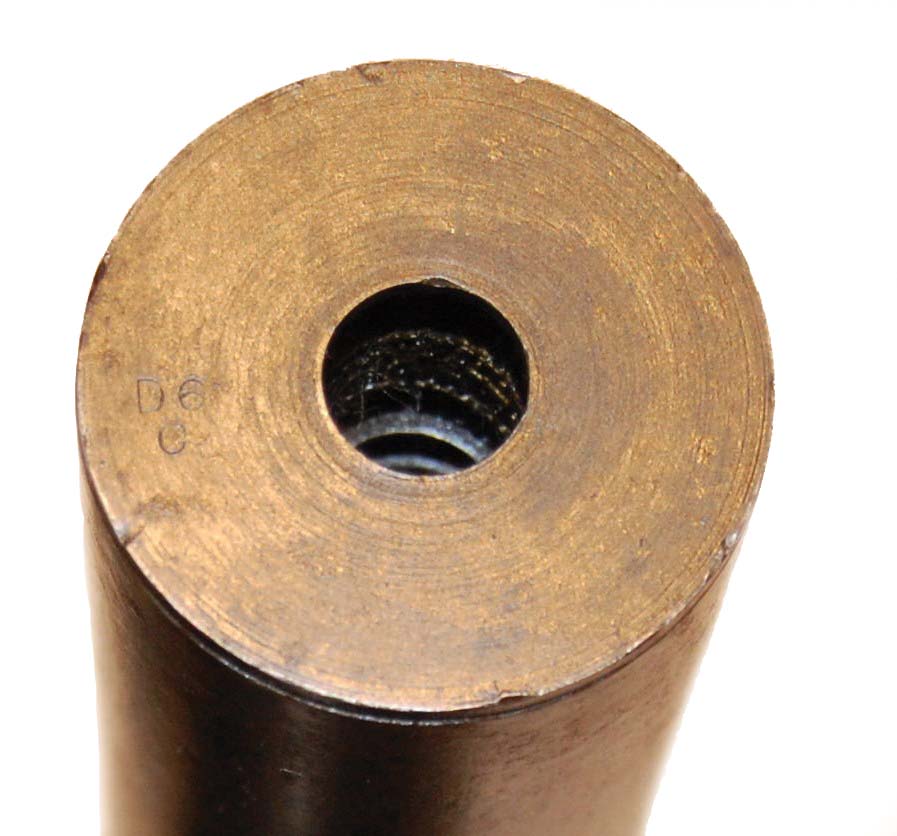
The British 9mm ammunition was the Mk.Iz, adopted in December 1941, using a 115 grain bullet at 1,200 fps. This ammunition turned out to be a little weak for the Sten gun, so a new cartridge was adopted in September 1943, the Mk.IIz, which used the same 115 grain bullet and a muzzle velocity of 1,300 fps. The introduction of the Mk.IIz loading cured some of the reliability issues, but made silencing more difficult. The silenced Sten guns were never intended for automatic fire, only for single shots. The guns retained their fully automatic capability to be saved for instances where it was necessary to use full auto fire to save lives or to secure the task at hand, but it was stressed that this would quickly ruin the silencing capability.
In design, the Sten gun is intended to have the primer set off by the firing pin when the cartridge stops against the chamber shoulder, but before the bolt stops its movement forward. In this design, some of the chamber pressure is used to stop the forward motion of the bolt. With the ventilated barrels of the early silenced versions, a lightened bolt and recoil spring had to be used in order to make the guns work. The E.S.6(W.D.) SOE design utilized a deeper chamber where the bolt would make contact with the breech end of the barrel before the cartridge was fired, so the chamber pressure in full could be used to work the bolt to the rear. This design allowed the use of a standard bolt and recoil spring in the silenced Sten and a theoretical use of the silencing unit in any Sten Mk.II available. In practice the SOE silencing units also had reliability issues.



Three main types of Special Sten/Sten Mk.II(S) have been observed in quantity as follows:
First production model silencing units are found on B.S.A. manufactured guns with B prefix in serial number series B 341000, B 360000 and B 363000. The silencing units are two inches in diameter and are not equipped with any web handguards. The insulation is integrated in the silencer between the inner and outer tubes of the silencer. All the weapons observed have had the letter “S” stamped on the bottom of the magazine housing. These Sten guns are typically marked STFN instead of STEN, indicating a worn die used for marking the guns.
The silencer has a number of metal discs in front of the 7.2 inch barrel, which is ventilated with 6 bleed holes. A thick rubber disc is placed at the muzzle of the silencing unit to stop the powder gases from escaping. The effect of the silencing unit decreases as the rubber disc wears out. A number of silencing units have been observed with light bullet strikes at the muzzle, possibly caused by firing in recent times after the rubber had hardened thus diverting the bullets.
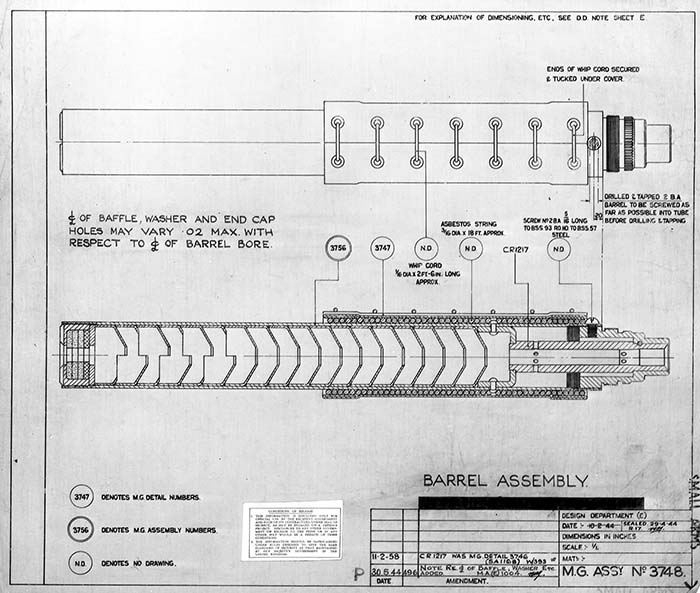
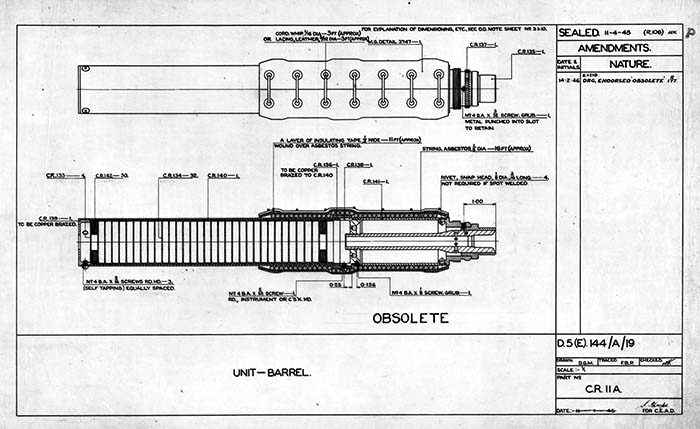
The silencing units are serial numbered and observations have been made in a range from 1-3400. It is not possible to say if as many as 3,400 were made but the observed numbers from 1-1500 have been so many that it’s quite possible that this range was filled. A number of these weapons were also equipped with night sights. Guns with night sights had the silencing unit permanently attached to the submachine gun. Most of the observed silencing units with night sights were in the 1-350 serial number range with one exception around serial number 3400. This model appears to have only been used by SOE agents. As mentioned above, these silencing units are possibly the shortened Kulikowski silencing units mentioned in the reports.
Second production model silencing units are found on guns with Serial numbers with TF prefix and a one and a half inch diameter silencing unit with asbestos string as insulation covered by a web handguard. These silencing units have a large threaded front cap in the muzzle that may be unscrewed for disassembly and cleaning. Instead of the metal discs, this silencing unit used a series of baffles stacked in front of the barrel and held in place by the muzzle cap. A felt disc was positioned inside the muzzle cap to help in sealing off the gases inside the silencing unit. The barrel is 3.62 inches long and has 10 bleed holes. The guns and silencing units are numbered to each other and the bolts appear to have been lightened on all the specimens observed. The guns are marked STEN MkIIS and are textbook examples of the official British army Sten MkII(S) as described in books and manuals.
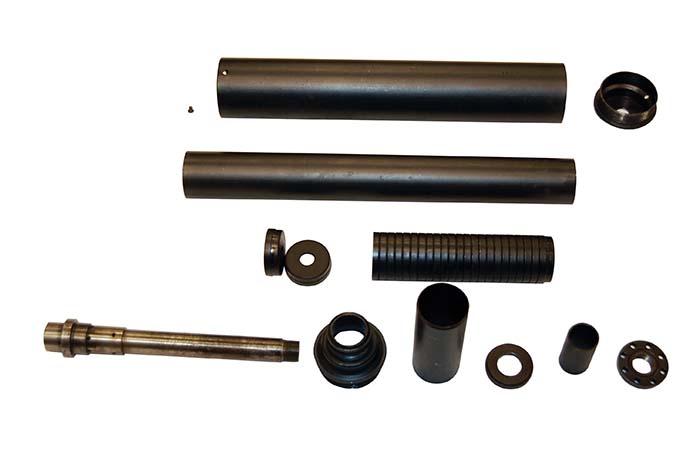
Third production model silencing units are found on Fazakerley manufactured guns with FP prefix on the serial numbers. This silencing unit also has a one and a half inch diameter tube but it is quite different from the previous model. The silencing unit has a collar about one third from the rear where it can be taken apart. Internally it has the same disc pattern as the first production model mentioned above, but it has a number of thin mesh discs in each end of the set of discs. The length of the barrel is 4.75 inches and it has 6 bleed holes. These silencing units were developed by E.S.6(W.D.) and used by the SOE. It appears that this silencing unit is a direct successor of the two inch diameter type. The guns and silencing units are numbered to each other and the serial number on the silencing unit will be found on the side of the tube in front of the web handguard. The insulation is provided by asbestos string, but on this silencer it is covered by insulating tape. The Sten guns do not have any special markings on the magazine housing. As mentioned above, the silencing units are visually very close to the Army Sten Mk.II(S) type and were named “Attachment no.6, Sten Machine Carbine, Mark 1, design E.S.6(W.D.).”
Although far from identical, all the known variations of the Sten gun silencing units have been made on a similar pattern. The silencing unit has a total length of 13-14 inches and a diameter of 1.5 to 2 inches. The barrel is fixed to the silencing unit, which replaces the barrel and shroud of a regular Sten Mk II. The silencing units of the first and second production model were specifically mated to their Sten guns and were not intended to be used on other guns. The third production model was also numbered to the guns but the intention was that it could be used on any Sten Mk.II.
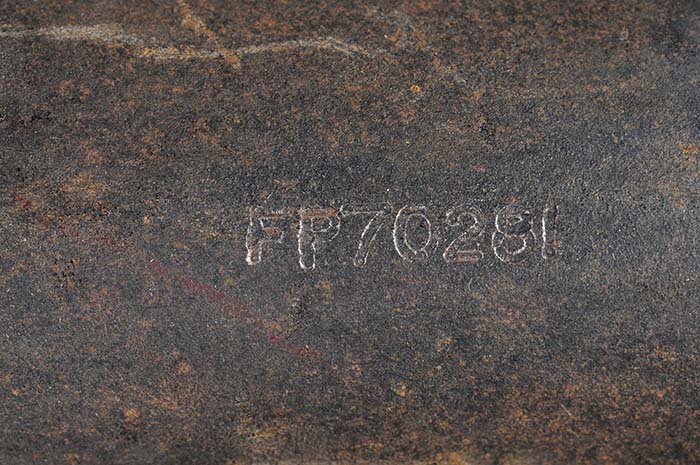

The quantities made of the various models of the Sten gun silencing units are very difficult to make estimates on. As mentioned, the first production model will be found with numbers between 1-3400, but it’s quite possible that only blocks of serial numbers were used. The second production model, the textbook STEN MkII(S), is reported to have been made in quantities of 2,500-6,000. The third production model is just as vague as neither the first nor the third model are often encountered outside Norway where they were sent by the SOE. It is probably safe to assume that the total number of silenced Mk.II Sten guns lie somewhere between five and ten thousand guns total.
During the research for this article more than one hundred silencing units were examined. Many of them were specimens that had been separated from their original weapon, but quite a few matching sets were also found. As the silencing unit easily disassembles from its Sten host, many of them have become lost souls over the years.
The barrels are short and ventilated to reduce the muzzle velocity to approximately the speed of sound to make the sound reduction more successful. Silenced Sten guns may not be as quiet as today’s MP5SD and other special weapons but they offered a significant reduction in sound signature and did away with the muzzle flash. Norwegian Resistance fighters used silenced Stens with great success in several documented killings of Nazi collaborators.
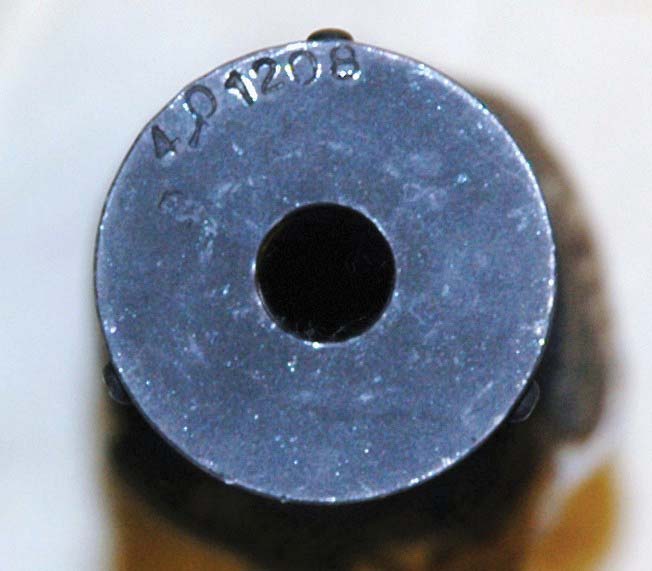
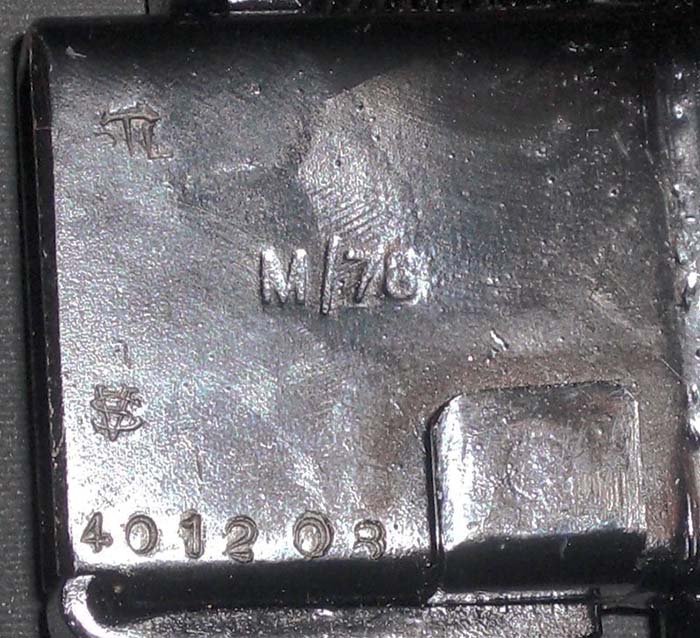
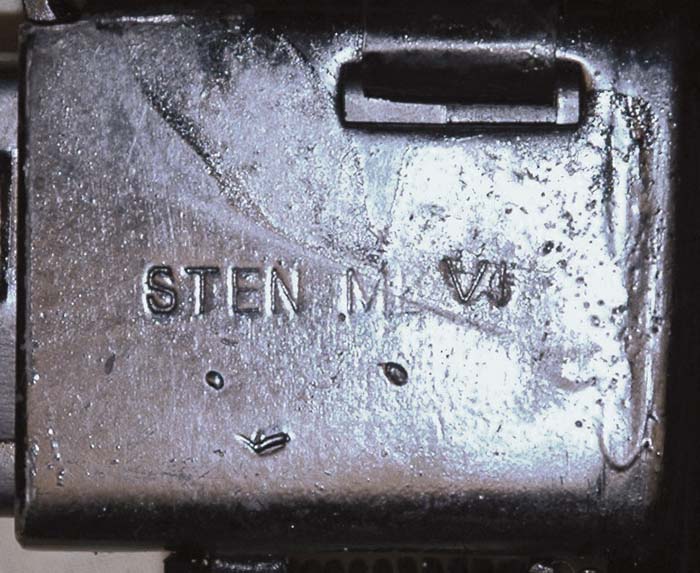
In Norway, the author’s native country, the textbook Sten Mk.II(S) by far the scarcest of the three main models and is very seldom encountered. This indicates that most of the silenced Sten guns in Norway were delivered by the SOE and not through the British Army.
A small number of Sten Mk.V submachine guns were also equipped with silencing units for trials. Silencing the Mk.V was complicated by the fact that it had the front sight on the barrel. A special clamp with a front sight was made for the Mk.V(S). The Mk.V(S) used the Mk.II(S) silencer and lightened bolt, but was not adopted. Instead it was decided to use the E.S.6(W.D.) units described above with the Sten Mk. V. A total of 50 guns were used in trials equipped with this silencer and the SOE method of deepened chamber appeared to work.
The last official Sten gun was the Sten Mk.VI, which was the Sten Mk.V with an E.S.6(W.D.) silencing unit attached and a front sight similar to the one on the Mk.II Sten. The Sten Mk.VI was first mentioned in a letter dated January 1945. It seems likely that this silencing unit is the “Attachment no.6, Sten Machine Carbine, Mark 2, design E.S.6(W.D.).” The silencing unit for the Sten Mk.VI is very close to the E.S.6(W.D.) unit for the Sten Mk.II except for minor details, the barrel is easily removable on the Mk.VI silencing unit. The serial number markings are found on the front end of silencing unit for the Sten Mk.VI, and match the guns they were issued with.
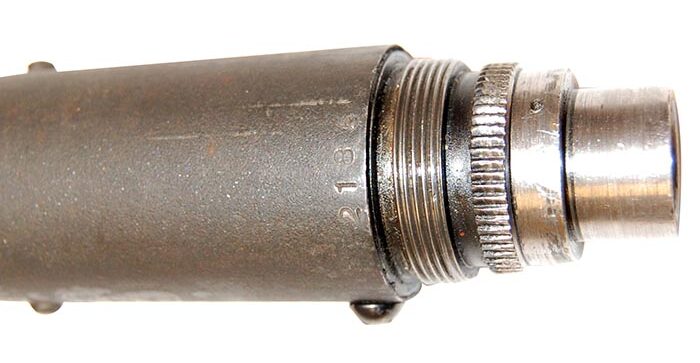
The Mark V and VI Sten guns had the sear positioned a bit further to the front than the Mk.II, so the problem of double taps or runaway guns was theoretically eliminated. In spite of this, these faults remained also with the Mk.VI. The Winchester ammunition had primers that were more sensitive than the ones used with the Mk.IIz ammunition. This resulted in the primer being ignited earlier and the weapon worked the same as any other Sten, with the recoiling case spending its energy to stop the bolt from going forward.
A large number of Sten Mk.VI appears to have been made, possibly as many as 25,000 guns according to some sources, but it seems that the production was stopped at 14,300 as the weapon proved unsatisfactory. 80% of the guns were issued to the SOE and 20% to the army.
Correspondence dated June 1945 indicates that the Mk.VI Sten was not successful and that most of them were never issued to the troops. Troubleshooting and altering of the bleed holes had been tried but the results were still not satisfactory. As the war was coming to an end it appears that the British army decided it would make do with the Sten Mk.II(S) guns that were already in stock.
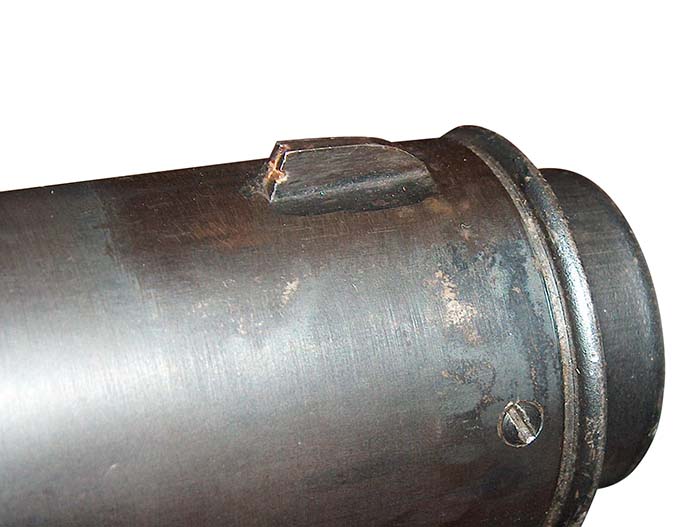
The Sten Mk.VI was declared obsolete as early as January 1946. Most of the Mk VI Sten guns were first decided to be converted back to Mk V configuration due to a lack of Sten guns in the British army in late 1945. It appears that the end of the war made this work unnecessary and it also appears that there was some reluctance to get into a work operation that could warrant another “mark” of Stens. Some silenced Stens of both MkII and Mk.VI types remained in use and were finally replaced by the Sterling L34A1. It is unknown today whether the Mk VI were scrapped for parts or supplied to unknown users, but it is a weapon that is seldom encountered.
After World War Two a number of “Stay Behind” organizations were formed in many European countries. These organizations were part of the countries’ secret service operations and were not known to the general public. The Stay Behind units were small but had access to a number of weapons and equipment that could be brought into service in the case of an attack from the Soviets. After the Cold War most of the units were disbanded and the equipment turned over to the military authorities that had supplied them. In Norway, the Stay Behind units had silenced Sten guns in their stores, mostly Mk.VI guns but also a good supply of locally made silencing units. The silencing units were made by Stay Behind armorer Bjørn Grøtting, and were rather crude in their appearance although quite effective. The Stay Behind silencing units were not made to be disassembled.
(Thank you: Askild Antonsen, Gjermund Fjeld, The Norwegian Armed Forces Museum, Oslo, Norway. Royal Armouries, Leeds, Dutch Army Museum, Delft, Hallvard Aasdalen, Morten Støen and a special thank you to Per Ove Bø, Richard D. Jones, Ian Patrick, all of whom greatly assisted in the research of this article.)
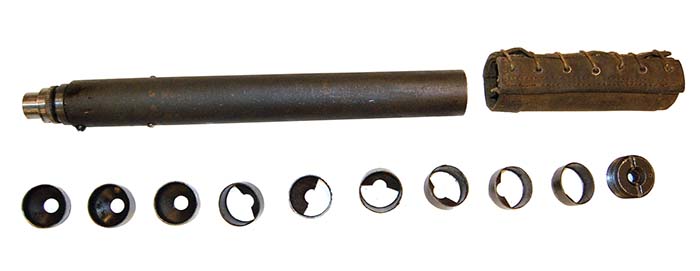
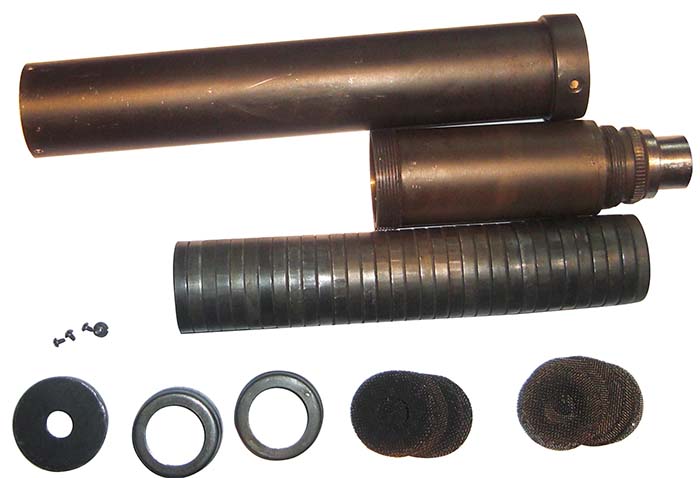
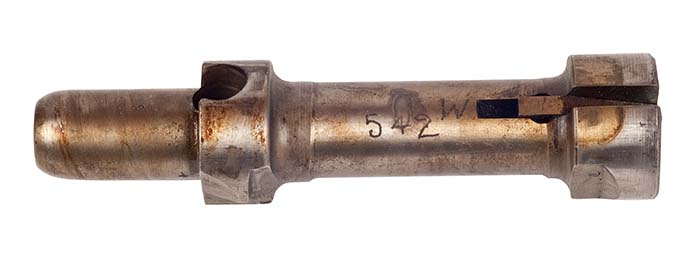
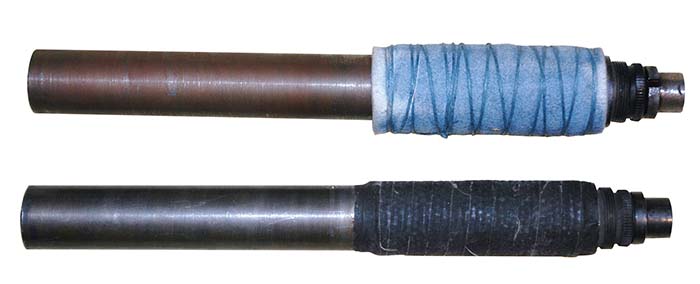
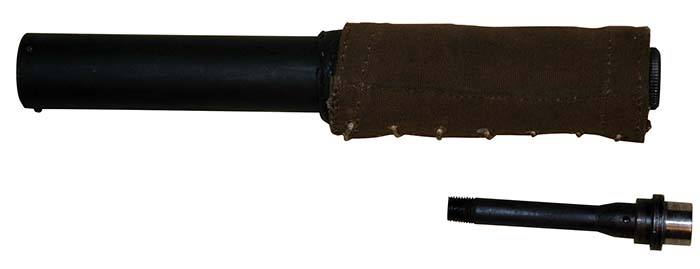

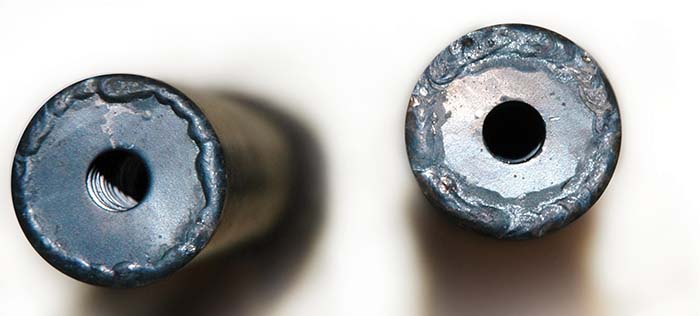
| This article first appeared in Small Arms Review V18N2 (April 2014) |











